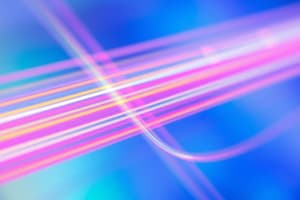Podcast
Questions and Answers
What is the principle behind optical fiber interferometers?
What is the principle behind optical fiber interferometers?
- Heisenberg Uncertainty Principle
- Hooke's Law principle
- Fabry-Perot Interferometer (FPI) principle (correct)
- Quantum entanglement principle
Which material is NOT mentioned as a humidity-sensitive material used in optical fiber humidity sensors?
Which material is NOT mentioned as a humidity-sensitive material used in optical fiber humidity sensors?
- Silicon dioxide (correct)
- Agarose
- Polyimide
- Polyvinyl alcohol (PVA)
What role do Fiber Bragg Gratings (FBGs) play in enhancing optical fiber interferometers?
What role do Fiber Bragg Gratings (FBGs) play in enhancing optical fiber interferometers?
- They reflect specific wavelengths of light (correct)
- They absorb humidity
- They make the interferometer less sensitive
- They increase the cavity length of the FPI
How do optical fiber interferometers measure changes in relative humidity?
How do optical fiber interferometers measure changes in relative humidity?
Which type of optical fiber structure has shown relatively high sensitivity and simple structures for humidity measurement?
Which type of optical fiber structure has shown relatively high sensitivity and simple structures for humidity measurement?
What is the purpose of using a humidity-sensitive material in an optical fiber humidity sensor?
What is the purpose of using a humidity-sensitive material in an optical fiber humidity sensor?
What type of sensor can be used to monitor temperature by reflecting light at a specific wavelength?
What type of sensor can be used to monitor temperature by reflecting light at a specific wavelength?
Which factor remains challenging in achieving all desired performances of optical fiber humidity sensors?
Which factor remains challenging in achieving all desired performances of optical fiber humidity sensors?
In addition to new humidity-sensitive materials, what else do researchers explore to improve optical fiber humidity sensors?
In addition to new humidity-sensitive materials, what else do researchers explore to improve optical fiber humidity sensors?
Which field benefits from the crucial role of optical fiber humidity sensors in monitoring and controlling humidity?
Which field benefits from the crucial role of optical fiber humidity sensors in monitoring and controlling humidity?
What enables high-performance sensors to provide accurate, real-time measurements in various applications?
What enables high-performance sensors to provide accurate, real-time measurements in various applications?
What characteristic of optical fiber humidity sensors makes them valuable for environmental monitoring?
What characteristic of optical fiber humidity sensors makes them valuable for environmental monitoring?
Flashcards are hidden until you start studying
Study Notes
Humidity Measurement Techniques in Optical Fiber Humidity Sensors
Optical fiber humidity sensors have gained increasing attention in recent years due to their potential to provide high-performance, long-distance sensing capabilities. These sensors are composed of an optical fiber structure interacting with a humidity-sensitive material, such as polyvinyl alcohol (PVA), polyimide, chitosan, or agarose. Among the various optical fiber structures, optical fiber interferometers have shown relatively high sensitivity and simple structures.
Optical Fiber Interferometers
Optical fiber interferometers are a common type of sensor used for humidity measurement. They work by exploiting the Fabry-Perot interferometer (FPI) principle, in which light is reflected between two mirrors, creating an interference pattern. In the case of humidity sensing, a humidity-sensitive material is used to alter the cavity length of the FPI, which in turn changes the wavelength of the reflected light. By monitoring this wavelength shift, the relative humidity (RH) can be determined.
Fiber Bragg Grating (FBG)
To enhance the performance of optical fiber interferometers, researchers often incorporate fiber Bragg gratings (FBGs) into the sensing probe. FBGs are periodic structures inscribed into the core of an optical fiber, which reflect specific wavelengths of light. By cascading an FBG with an FPI sensing probe, it becomes possible to monitor both humidity and temperature changes simultaneously. The FBG can be used to monitor temperature by reflecting light at the wavelength corresponding to the Bragg condition, while the FPI sensing probe measures humidity.
Challenges and Future Developments
Despite the advances in optical fiber humidity sensors, achieving all desired performances, including high sensitivity, large measurement ranges, fast response speeds, and good repeatability remains challenging. To overcome these challenges, researchers continue to explore new sensor designs by combining new humidity-sensitive materials with various optical fiber structures and fabrication techniques.
In summary, optical fiber humidity sensors play a crucial role in monitoring and controlling humidity in various fields such as food, medicine, storage, and environmental monitoring. The use of optical fiber interferometers, FBGs, and novel humidity-sensitive materials has enabled the development of high-performance sensors that can provide accurate, real-time measurements in a range of applications.
Studying That Suits You
Use AI to generate personalized quizzes and flashcards to suit your learning preferences.




